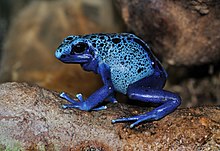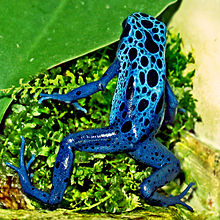Blue Poison Dart Frog Where Do Blue Poison Dart Frogs Live
| Blue poison dart frog | |
|---|---|
 | |
| Conservation status | |
| Not evaluated (IUCN 3.1)[1] | |
| Scientific classification | |
| Kingdom: | Animalia |
| Phylum: | Chordata |
| Class: | Amphibia |
| Order: | Anura |
| Family: | Dendrobatidae |
| Genus: | Dendrobates |
| Species: | D. tinctorius |
| Subspecies: | D. t. "azureus" |
| Trinomial name | |
| Dendrobates tinctorius "azureus" (Hoogmoed, 1969) | |
The blue poison dart frog or blue poison arrow frog (Dendrobates tinctorius "azureus") is a poison dart frog found in the forests surrounded by the Sipaliwini Savanna, which is located in southern Suriname (known in Surinamese Dutch as blauwe pijlgifkikker ) and adjacent far northern Brazil. D. tinctorius azureus is also known by its indigenous Tirio name, okopipi. Its scientific name comes from its azure (blue) color. While frequently considered a valid species in the past, recent authorities treat it as a variant of D. tinctorius.[1] [2]
Description [edit]

D. tinctorius "azureus" frogs in captivity.
D. tinctorius "Azureus" is a medium-sized frog that weighs about 8 g and grows to 3.0-4.5 cm in length. Females are larger and about half a centimetre longer than males, but males have larger toes. The frog has a typical lifespan of five to seven years in the wild. Its bright blue skin, usually darker around its limbs and stomach, serves as a warning to predators. The glands of poisonous alkaloids located a defence mechanism to potential predators. These poisons paralyze and sometimes kill the predator. The black spots are unique to each frog, enabling individuals to be identified. This species of frog has a distinctive hunch-backed posture. Each foot has four toes, which each have a flattened tip with a suction cup pad used for gripping. The tips of the toes in females are round, while males have heart-shaped tips.
As with almost all frogs, tadpoles differ greatly in appearance from adults. They have a long tail, about 6 mm, with a total length of around 10 mm. They lack legs and have gills instead of lungs.
Behavior [edit]

D. tinctorius "Azureus" the blue poison dart frog is a mainland animal, but stays close to water sources. These frogs spend most of their awake time, during the day, hopping around in short leaps. They are very territorial and aggressive both towards their own species and others. To ward off intruders, they use a series of calls, chases, and wrestling. Although poison dart frogs are known for their skin toxins, used on the tips of arrows or darts of natives, in reality only the species of the genus Phyllobates are used in this manner. In captivity, the frogs lose toxicity as a result of altered diets.
Reproduction [edit]
The blue poison dart frog breeds seasonally, usually during February or March when the weather is rainy. To find mates, the males sit on a rock and produce quiet calls, which the females follow to track down the males. The females then physically fight over a male. The male takes the female to a quiet place by the water, which becomes the site of the egg-laying. Fertilization occurs externally; once the eggs are laid, the male covers them in his sperm.
Between five and 10 offspring are produced at each mating. Eggs are laid in the male's territory, which he defends. The male takes care of the eggs, sometimes joined by the female. The eggs hatch after 14 to 18 days, and after 10 to 12 weeks the tadpoles are fully mature. Both sexes reach sexual maturity at two years of age. The expected lifespan of D. tinctorius Azureus is between 4 and 6 years in the wild and about 10 years in captivity.
Feeding [edit]
The blue poison dart frog feeds on ants, beetles, flies, mites, spiders, termites, maggots, and caterpillars.
Captive care [edit]
In captivity, like most captive dart frogs, they eat a staple diet of fruit flies, pinhead crickets, rice flour beetle larvae, and springtails.
References [edit]
- ^ a b Philippe Gaucher; Ross MacCulloch (2010). "Dendrobates tinctorius". IUCN Red List of Threatened Species. 2010: e.T55204A11265402. doi:10.2305/IUCN.UK.2010-2.RLTS.T55204A11265402.en.
- ^ Wollenberg, Katharina C.; Veith, Michael; Noonan, Brice P.; Lötters, Stefan (2006). Quattro, J. M (ed.). "Polymorphism Versus Species Richness—systematics of Large Dendrobates from the Eastern Guiana Shield (Amphibia: Dendrobatidae)". Copeia. 6 (4): 623. doi:10.1643/0045-8511(2006)6[623:PVSROL]2.0.CO;2.
External links [edit]
![]()
![]() Media related to Dendrobates azureus at Wikimedia Commons
Media related to Dendrobates azureus at Wikimedia Commons
- University of Michigan
Source: https://en.wikipedia.org/wiki/Blue_poison_dart_frog
0 Response to "Blue Poison Dart Frog Where Do Blue Poison Dart Frogs Live"
Postar um comentário